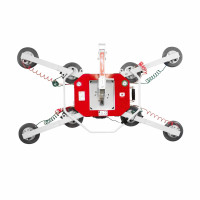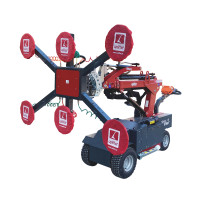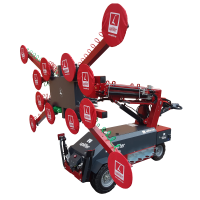Introduction to Vacuum Glass Lifters
Glass installation and handling can be a challenging task, especially when dealing with large glass panes or smooth surfaces. In the past, manual handling methods were used, which not only required significant manpower but also posed a risk to the safety of workers and the integrity of the glass. However, with advancements in technology, the introduction of vacuum glass lifters has revolutionized the glass industry. Vacuum glass lifters are powerful tools that maximize efficiency and safety by providing a secure grip on glass panes and other smooth surfaces. In this article, we will explore the advantages of using vacuum glass lifters, how they work, the different types available, factors to consider when choosing one, safety features, applications, maintenance, and care, as well as case studies of successful projects.
The Advantages of Using Vacuum Glass Lifters
Using vacuum glass lifters offers numerous advantages over traditional glass handling methods. Firstly, they significantly increase efficiency and productivity. With manual methods, it would take several workers to lift and maneuver a heavy glass pane, requiring time and effort. However, vacuum glass lifters can easily handle large glass panes with a single operator, reducing the time and manpower required for the job. This increased efficiency translates into cost savings for businesses, allowing them to complete projects more quickly and effectively.
Secondly, vacuum glass lifters enhance safety in the workplace. Traditional glass handling methods involve a higher risk of accidents, such as glass breakage and injuries to workers. Vacuum glass lifters eliminate these risks by securely gripping the glass pane using suction cups or pads. This ensures a stable hold, reducing the likelihood of accidents and injuries. Additionally, vacuum glass lifters often come equipped with safety features like warning alarms and pressure sensors, further enhancing the safety of both the workers and the glass being handled.
Furthermore, using vacuum glass lifters minimizes the risk of damage to the glass pane or smooth surface. The suction cups or pads create an airtight seal, distributing the weight evenly and preventing any pressure points that could lead to cracks or breaks. This is particularly important when dealing with delicate or expensive glass, as any damage could result in significant financial losses. Vacuum glass lifters provide a secure grip without compromising the integrity of the glass, ensuring that it remains intact and undamaged throughout the lifting and installation process.
How Vacuum Glass Lifters Work
Vacuum glass lifters utilize the power of suction to securely lift and move glass panes and other smooth surfaces. The lifting mechanism consists of suction cups or pads that create an airtight seal with the glass surface. When the vacuum is activated, the air is removed from between the suction cups and the glass, creating negative pressure and causing the cups to firmly grip the glass. This suction force allows the glass lifter to hold and manipulate the glass pane safely.
The vacuum glass lifter is typically connected to a lifting device, such as a crane or forklift, which provides the necessary lifting power. The lifter is designed with a sturdy frame and a handle for easy maneuverability. Some vacuum glass lifters also come with additional features, such as rotation capabilities, allowing the glass pane to be positioned at various angles during installation.
It is important to note that the suction cups or pads used in vacuum glass lifters are designed to be non-marking, meaning they do not leave any residue or marks on the glass surface. This ensures that the glass remains clean and free from any unsightly marks or smudges, maintaining its aesthetic appeal.
Types of Vacuum Glass Lifters
There are various types of vacuum glass lifters available in the market, each designed to cater to specific needs and requirements. The most common types include:
- Manual Vacuum Glass Lifters: These lifters are operated manually, with the operator using a hand pump to create the necessary vacuum. Manual vacuum glass lifters are lightweight and portable, making them suitable for smaller glass panes or projects that require frequent movement.
- Powered Vacuum Glass Lifters: Powered lifters use an electric or pneumatic pump to create and maintain the vacuum. These lifters are more suitable for larger glass panes or projects that require extended periods of lifting and holding.
- Vacuum Glass Robots: Vacuum glass robots are automated systems that can handle multiple glass panes simultaneously. These robots are often used in large-scale projects that require high precision and efficiency.
- Specialized Vacuum Glass Lifters: There are also specialized vacuum glass lifters designed for specific applications, such as curved glass or irregularly shaped surfaces. These lifters are customized to ensure a secure grip and safe handling of the unique glass shapes.
When choosing a vacuum glass lifter, it is important to consider factors such as the weight and size of the glass panes to be lifted, the required lifting capacity, and the specific project requirements. Consulting with a reputable supplier or manufacturer can help determine the most suitable lifter for the job.
Factors to Consider When Choosing a Vacuum Glass Lifter
Selecting the right vacuum glass lifter for your project is crucial to ensure efficient and safe glass handling. There are several factors to consider when making your decision:
- Lifting Capacity: Determine the maximum weight and size of the glass panes that need to be lifted. Ensure that the vacuum glass lifter has the necessary lifting capacity to handle the specific requirements of your project.
- Number of Suction Cups or Pads: The number and arrangement of suction cups or pads will affect the lifter's gripping ability. Consider the surface area of the glass pane and choose a lifter with an appropriate number and configuration of suction cups or pads to ensure a secure grip.
- Power Source: Decide whether a manual or powered vacuum glass lifter is more suitable for your project. Manual lifters are more portable and suitable for smaller glass panes, while powered lifters offer greater lifting capacity and endurance.
- Safety Features: Look for lifters with safety features such as warning alarms, pressure sensors, and automatic release mechanisms. These features enhance the safety of both the workers and the glass being handled.
- Ease of Use and Maneuverability: Consider the ergonomics of the lifter, including the handle design and the ease of maneuverability. A well-designed lifter with intuitive controls will enhance operator comfort and efficiency.
By carefully considering these factors, you can choose a vacuum glass lifter that meets your project's specific requirements, ensuring optimal performance and safety.
Safety Features of Vacuum Glass Lifters
Safety is of utmost importance when using vacuum glass lifters. These lifters are designed with several safety features to protect both the workers and the glass being handled. Some common safety features include:
- Warning Alarms: Vacuum glass lifters are equipped with warning alarms that alert the operator in case of any issues or abnormalities. These alarms help prevent accidents by providing timely notifications and allowing the operator to take appropriate action.
- Pressure Sensors: Pressure sensors are used to monitor the vacuum pressure and ensure that it remains within the optimal range. If the pressure drops below or exceeds the safe limit, the lifter will automatically release the glass, preventing any potential accidents.
- Backup Power Supply: Powered vacuum glass lifters often come with a backup power supply, such as a rechargeable battery. This ensures that even in the event of a power failure, the lifter can safely hold and release the glass pane.
- Emergency Stop Button: An emergency stop button is provided for immediate termination of the lifting operation in case of an emergency or any unforeseen circumstances.
These safety features provide an additional layer of protection and help minimize the risk of accidents or damage during glass handling operations. It is essential to familiarize yourself with the specific safety features of your chosen vacuum glass lifter and ensure that they are in proper working condition before each use.
Applications of Vacuum Glass Lifters
Vacuum glass lifters find applications in a wide range of industries and projects. Some common applications include:
- Architectural Glass Installation: Vacuum glass lifters are extensively used in the installation of glass windows, curtain walls, and glass facades in buildings. They provide a secure and efficient method of handling large glass panes and ensure precise placement during installation.
- Glass Manufacturing: Vacuum glass lifters play a crucial role in the manufacturing process of glass products. They are used to lift and transport glass sheets, enabling seamless production and minimizing the risk of breakage or damage.
- Renovation and Restoration Projects: When restoring or renovating historical buildings, vacuum glass lifters are used to handle delicate and valuable glass pieces. They provide a safe and reliable method of lifting and positioning antique glass windows and other decorative glass elements.
- Automotive Industry: Vacuum glass lifters are employed in the automotive industry for handling windshields and other glass components during assembly or repair processes. They ensure precise placement and reduce the risk of damage to the glass.
- Retail and Commercial Spaces: In retail and commercial spaces, vacuum glass lifters are used for the installation of glass partitions, display cases, and other glass features. They allow for efficient and safe handling of large glass panels, contributing to the overall aesthetic appeal of the space.
These are just a few examples of the diverse applications of vacuum glass lifters. Their versatility and reliability make them an indispensable tool in various industries where the safe and efficient handling of glass panes and smooth surfaces is required.
Maintenance and Care of Vacuum Glass Lifters
Proper maintenance and care are essential to ensure the longevity and optimal performance of vacuum glass lifters. Here are some important maintenance tips to consider:
- Regular Inspection: Conduct regular inspections of the lifter to check for any signs of wear, damage, or malfunctions. Pay close attention to the suction cups or pads, hoses, and vacuum pump. Any issues should be addressed promptly to avoid compromising the lifter's performance or safety.
- Cleaning and Lubrication: Clean the suction cups or pads and the lifter's frame regularly to remove any dirt, debris, or residue that may affect the lifter's gripping ability. Lubricate the moving parts as recommended by the manufacturer to ensure smooth operation.
- Check Vacuum Pressure: Periodically check the vacuum pressure using a pressure gauge to ensure that it remains within the optimal range. If any fluctuations are detected, investigate and rectify the issue before using the lifter.
- Operator Training: Provide proper training to the operators on the correct and safe use of the vacuum glass lifter. This includes demonstrating how to create the vacuum, operate the lifter, and engage the safety features. Regular refresher training sessions can help reinforce safe handling practices and prevent accidents.
- Storage and Transportation: Store the vacuum glass lifter in a clean and dry environment, away from extreme temperatures and direct sunlight. When transporting the lifter, ensure that it is securely fastened to prevent any damage or accidents.
By following these maintenance guidelines and adhering to the manufacturer's recommendations, you can ensure that your vacuum glass lifter remains in optimal condition, guaranteeing safe and efficient glass handling operations.
Case Studies of Successful Projects Using Vacuum Glass Lifters
Case Study 1: Glass Facade Installation
A high-rise building in the heart of the city required the installation of a large glass facade. The project involved handling multiple glass panels, each weighing several tons. The use of traditional glass handling methods would have required a significant amount of manpower and time. However, by employing vacuum glass lifters, the project was completed efficiently and safely.
The vacuum glass lifters were able to securely grip the glass panels, allowing them to be lifted and maneuvered with ease. The lifters' rotation capabilities enabled precise positioning of the glass, ensuring a seamless installation. The project was completed ahead of schedule, saving both time and costs for the construction company.
Case Study 2: Antique Glass Window Restoration
A historical building undergoing restoration required the careful handling of antique glass windows. These windows were delicate and valuable, requiring a solution that would ensure their safety during the restoration process. Vacuum glass lifters were chosen for their ability to provide a secure grip without causing any damage to the glass.
The lifters allowed the restoration team to lift and position the antique glass windows with precision. The suction cups created an airtight seal, evenly distributing the weight and minimizing the risk of breakage. The project was a success, with the antique glass windows being restored to their former glory without any incidents or damage.
These case studies highlight the effectiveness and versatility of vacuum glass lifters in various glass handling projects. By choosing the right lifter for the specific requirements of the project, businesses can achieve efficient and safe glass handling operations, resulting in successful outcomes.
Conclusion: The Future of Vacuum Glass Lifters
Vacuum glass lifters have revolutionized the glass industry by maximizing efficiency and safety in glass handling operations. Their ability to securely grip glass panes and other smooth surfaces has significantly reduced the risk of accidents and damage, while also improving productivity. With advancements in technology, vacuum glass lifters are becoming more sophisticated and specialized, catering to a wide range of applications and project requirements.
As the demand for glass continues to grow in various industries, the future of vacuum glass lifters looks promising. Manufacturers are constantly innovating to enhance the lifter's capabilities, improve safety features, and increase overall efficiency. By embracing the power of vacuum glass lifters, businesses can streamline their glass handling processes, save costs, and ensure the safety of their workers and glass products.
Whether it is the installation of glass facades in skyscrapers, the restoration of antique glass windows, or the manufacturing of automotive glass, vacuum glass lifters have become an indispensable tool in the glass industry. By harnessing their power, businesses can maximize efficiency, enhance safety, and achieve successful outcomes in their glass handling projects.
Ready to experience the power of vacuum glass lifters for your glass handling needs? Contact us today to discuss your project requirements and find the perfect lifter for your needs.












Fantastic
I have a manual vacuum glas lifter and I am very happy with it.